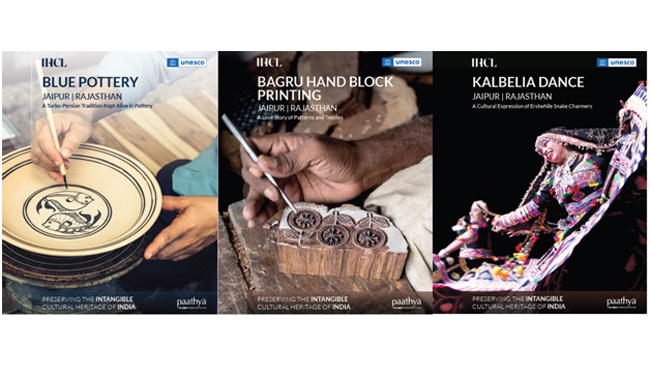
JAIPUR, AUGUST 10, 2022.
Long heralded as the custodians of Indian heritage, the history of Indian
Hotels Company (IHCL), India’s largest hospitality company,
is tightly woven into the fabric of India’s rich culture. Led by the values of Paathya – IHCL’s ESG+ framework – one
of IHCL’s key focus areas is preserving and promoting India’s intangible
cultural heritage. With this objective, IHCL has collaborated with UNESCO
to offer experiential tours for
travellers at various IHCL hotels including
Rambagh Palace, Jaipur.
Special
itineraries allow in-house Palace guests to experience an authentic Kalbelia
performance at the tribal village, or learn about the intricacies of blue
pottery making or even try their hand at Bagru hand block printing at the local
artisan villages, a short distance from Jaipur.
Speaking about
these unique experiences in collaboration with UNESCO, Mr. Ashok S Rathore, Area Director-Jaipur & Ajmer and General
Manager –Rambagh Palace, stated, “The Pink City of Jaipur is world
renowned, not just for its rich history, but also for the many local arts that
have originated here. As part of IHCL’s Paathya initiatives, we are delighted
to collaborate with UNESCO to conserve and retain the indigenous crafts of the
respective artisans, and offer guests an opportunity to understand the
intricacies and legacies of these centuries-old art.”
Each of the three
itineraries offered at Rambagh Palace have been curated so that guests can
experience the living heritage of Jaipur’s crafts better.
BLUE POTTERY
Blue Pottery, a
Turko-Persian tradition, has been kept alive by the artisanshailing from a
small village of Sanganer, about 15 kms from Jaipur. Named after the
eye-catching ultramarine blue dye, derived from cobalt oxide, to colour the
pottery, is what gives this art form its name. Unconventionally crafted from
quartz and not clay, each piece is painstakingly fashioned by hand. Artisans
deftly paint Mughal-inspired patterns as well as animal and bird motifs on a
variety of plates, vases, glazed tiles, and more.
BAGRU ART
Very close to the
city of Jaipur is the village of Bagru, which houses the extremely skilled
artisans of the Chhipa community. These artisans are known for their block
printing and mud resist printing techniques, practiced for over 500 years now. The
artisans use Sheesham-wood blocks that are hand-carved with intricate motifs,
which are then dipped into natural dyes, also made by artisans, before being
imprinted onto the textiles. In the Dabu technique, a locally prepared mix of
mud is used as a colour-resistant on the textiles. With significant manual
labour and sun-drying involved, both these techniques consume time and effort.
KALBELIA DANCE
Kalbelia dance is
a cultural expression of erstwhile snake charmers, who often live outside
villages and cities in makeshift camps called Deras. Performed primarily by the
women of the tribe, the dance involves imitating the movements of a serpent to
the enchanting tunes of a traditional Poongi or Been instrument played by the
men. The sight of the women gracefully swaying in their distinctive black
lehengas and elaborate jewellery to the reverberating rhythm of traditional
Rajasthani folk instruments, is what makes this dance form unique.
For more details
about IHCL’s collaboration with UNESCO under Paathya, which will see
the adoption of 100% ofIntangible
Cultural Heritage (IHC) projects in the geographies the company operates
in, please visit here.
Derived from the Sanskrit
termपथ्य, inferring a path, Paathyaaims tolead positive change guided by IHCL’s core
values of Trustof all stakeholders, Awarenessaround the needs of our
ecosystem and Joy at heart.
Under Paathya, IHCL will continue to pioneer sustainable practices in its
pursuit towards excellence and creating benchmark in the tourism industry.